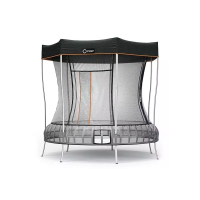4
Safety Information
2.1. Select Protective Surfacing
One of the most important things you can do to reduce
the likelihood of serious head injuries is to install shock-
absorbing protective surfacing under and around your play
equipment. The protective surfacing should be applied to a
depth that is suitable for the equipment height in accordance
with ASTM Specification F1292. There are different types of
surfacing to choose from; whichever product you select,
follow these guidelines:
2.1.1. Maintain a minimum depth of 9 in. (229 mm) of
loose-fill materials such as wood mulch/chips, engineered
wood fiber (EWF), or shredded/recycled rubber mulch for
equipment up to 96 in. (2438 mm) high; and 9 in. (229 mm)
of sand or pea gravel for equipment up to 60 in. (1524 mm)
high.
NOTE: An initial fill level of 12 in. (305 mm) will compress
to about a 9 in. (229 mm) depth of surfacing over time.
The surfacing will also compact, displace, and settle, and
should be periodically refilled to maintain at least a 9 in.
(229 mm) depth.
2.1.2. Use a minimum of 6 in. (152 mm) of protective surfacing
for play equipment less than 48 in. (1219 mm) in height. If
maintained properly, this should be adequate. (At depths
less than 6 in. (152 mm), the protective material is too easily
displaced or compacte
NOTE : Do not install home playground equipment over
concrete, asphalt, or any other hard surface. A fall onto a
hard surface can result in serious injury to the equipment
user. Grass and dirt are not considered protective surfacing
because wear and environmental factors can reduce their
shock absorbing effectiveness. Carpeting and thin mats are
generally not adequate protective surfacing. Ground level
equipment – such as a sandbox, activity wall, playhouse or
other equipment that has no elevated play surface – does
not need any protective surfacing.
2.1.3. Use containment, such as digging out around the
perimeter and/or lining the perimeter with landscape
edging. Don’t forget to account for water drainage.
2.1.3.1. Check and maintain the depth of the loose-fill
surfacing material. To maintain the right amount of loose-
fill materials, mark the correct level on play equipment
Maximum Swing fall height: 2,226 mm (88 in.)
United States Consumer Product Safety Commission’s
(USCPSC) Outdoor Home Playground Safety Handbook.
See below:
support posts. That way you can easily see when to
replenish and/or redistribute the surfacing.
2.1.3.2. Do not install loose fill surfacing over hard
surfaces such as concrete or asphalt.
2.2. Poured-In-Place Surfaces or Pre-
Manufactured Rubber Tiles
You may be interested in using surfacing other than loose-
fill materials, like rubber tiles or poured-in-place surfaces.
2.2.1. Installations of these surfaces generally require a
professional and are not “do-it-yourself” projects.
2.2.2. Review surface specifications before purchasing this
type of surfacing. Ask the installer/manufacturer for a report
showing that the product has been tested to the following
safety standard: ASTM F1292 Standard Specification for
Impact Attenuation of Surfacing Materials within the Use
Zone of Playground Equipment. This report should show the
specific height for which the surface is intended to protect
against serious head injury. This height should be equal to
or greater than the fall height – vertical distance between
a designated play surface (elevated surface for standing,
sitting, or climbing) and the protective surfacing below – of
your play equipment.
2.2.3. Check the protective surfacing frequently for wear.
2.3. Placement
Proper placement and maintenance of protective surfacing
is essential. Be sure to:
2.3.1. Extend surfacing at least 72 in. (1829 mm) from the
equipment in all directions.
2.3.2. For to-and-fro swings, extend protective surfacing
in front of and behind the swing to a distance equal to
twice the height of the top bar from which the swing is
suspended.
2.3.3. For 360º swings, extend surfacing in a circle whose
radius is equal to the height of the suspending chain or
rope, plus 6 ft in all directions.

